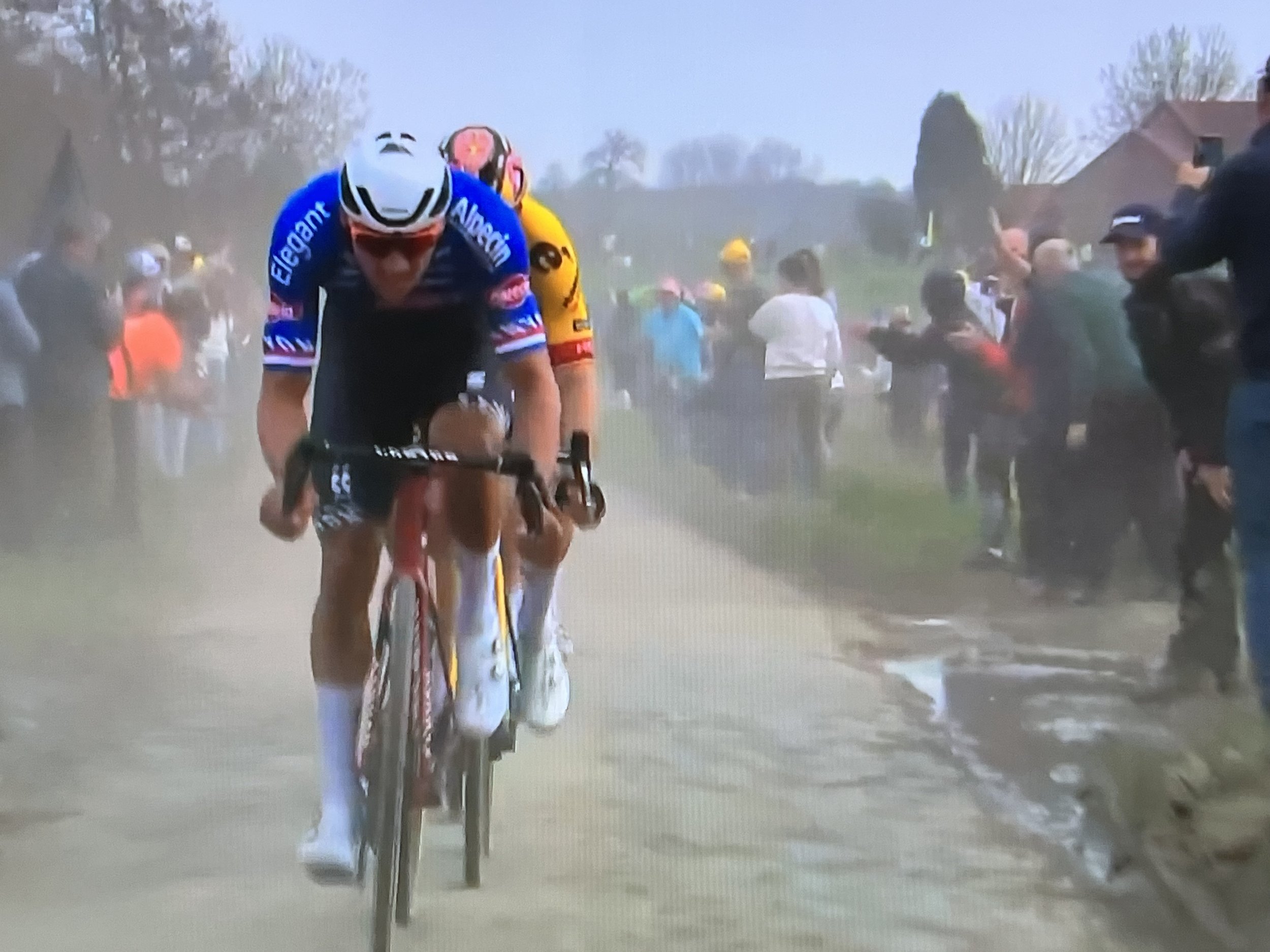Sector-20
Paris-Roubaix was decided on Sector-20 of the race, Haveluy à Wallers, a four-star (one-star is smoothest, five-star the hardest) rated cobblestone farm path that began at kilometer 151.1, just over 100-k to the finish.
The peloton had raced at record speed from the start, 51-kilometers covered in the first hour, the pace unrelenting the entire day. Ineos-Grenadiers had done yeoman’s work in keeping their star Filippo Ganna near the front the entire day while van der Poel’s Alpecin team raced in the most predatory manner I’ve seen from them yet, always in the front and probing.
Cofavorite Wout Van Aert had punctured just before the sector, come back through the follow cars on his own, picked up his team – which had been surprisingly passive up to that point –went straight through the peloton to hit the front of the race where the collective launched their star at the highest speed possible into the mouth of Sector-20.
Any worries about Van Aert’s - most relative - weaknesses in the previous races were forgotten by him and everyone else when the Belgian lay down such a brutal acceleration on the stones, skimming over them at such high speed, that behind was nothing but sheer chaos. Mathieu van der Poel fought hard to regain his archrival’s wheel, Stefan Küng turned himself inside out with effort with only John Degenkolb, the unlucky German, and Jumbo-Visma teammate Christian Laporte able to hold without opening any gaps. Laporte – what a metamorphosis the Frenchman’s undergone! – relayed Van Aert blasting at the front with the same level of force, pulling the group even further ahead.
Behind, nothing but gaps and struggling racers: Mads Pedersen was in the first chase group along with Alexander Kristoff, while even further behind was group three headed by Ineos’s Connor Swift fighting with everything he had to bring Ganna – who’d really gone backwards on those stones –into contention. Ganna and Pedersen, the two most dangerous outsiders for the win, would make their way back to the front but the efforts it cost them dearly, especially Pedersen’s remarkable solo effort through the next, five-star Trouèe d’Arenberg, cost them so much in terms of effort that they were damaged for the rest of the race, never really able to mount any resistance to the assaults of VdP and Van Aert. It had been a perfect planned and executed surgical strike by Van Aert and his team.
Every plan smacks up against reality which came true when Laporte flatted at the exit of the Arenberg leaving Van Aert isolated, while from behind Ganna came up but towing two of van der Poel’s teammates - pure sprinter Jasper Philipsen and Gianni Vermeersch- giving the Dutch star considerable tactical advantage for the rest of the race, advantage that the team would use in a masterful manner. The two men from the Alpecin-Elegant team, especially Vermeersch, buried themselves on the front to hold the now 13-racers ahead of Laporte, chasing with teammate Van Hooydonck, the duo around a minute behind. This Jumbo-Visma pressure from behind insured that almost everyone in the break was working and that Van Aert could remain passive.
50-k to go and van der Poel launches one of his spectacular, ricocheting-off-the-grass-banking attacks, reducing the front group to seven: van der Poel and Philipsen (Alpecin-Elegant), Pedersen (Trek-Segafredo), Ganna (Ineos), Küng (Groupama-FDJ), Degenkolb (DSM), and Van Aert (Jumbo-Visma). Van der Poel kept up a barrage of attacks from then on, marked by Van Aert and a resurrected Degenkolb, attacks that clearly showed the weaknesses of Ganna, Pedersen and Küng who struggled to follow yet tenaciously did.
Philipsen, a pure sprinter up till now, considered perhaps the fastest of all, became something else altogether that Sunday in Hell, because he was riding with the strength of a pure Classics man. On the front, covering for vdP’s attacks with ease, the Belgian represented a major threat to the others because they simply couldn’t count on him to be dropped, giving Alpecin two real threats for the victory.
Degenkolb, riding a fairytale race, with only 16-k to the end, was caught in a Team Alpecin sandwich, and found himself on the ground. It was an unintentional crash, one that was terribly unfair - the German was riding blow for blow with the two favorites - yet that’s cycling. He’d finish 7th, 2’35” down, completely crushed, and distraught over the loss of his magical chance at a comeback.
Van Aert, who had been carefully monitoring the break, only really moving when van der Poel went, seemed really at ease and to be waiting for his moment, which came at kilometer-239 on the final Five-Star, Carrefour de l’Arbe, 2.1-kilometers of rough stones. He attacked with the same incredible force as he had on Sector-20, blowing the break into pieces, with only van der Poel able to follow, who then come through to work. It was there, at the end of Sector-4, that we cycling fans were deprived of what should have been our Ali-Frazier moment, our Heavyweight Championship of the World. Van Aert suffered a tire failure, this the third crucial one for his team, and Mathieu van de Poel was free to fly, alone, to victory. Philipsen completed his team’s triumph by winning the sprint for second ahead of a dejected Van Aert, 46” down.
So many incidents, so many what ifs. Yet, it all comes down to the words of the late, great, team owner and mentor, Jean de Gribaldy: “There are riders who flat, miss breaks, fall sick or crash. And then, there are the riders who win.” Mathieu van der Poel is a rider who wins.
